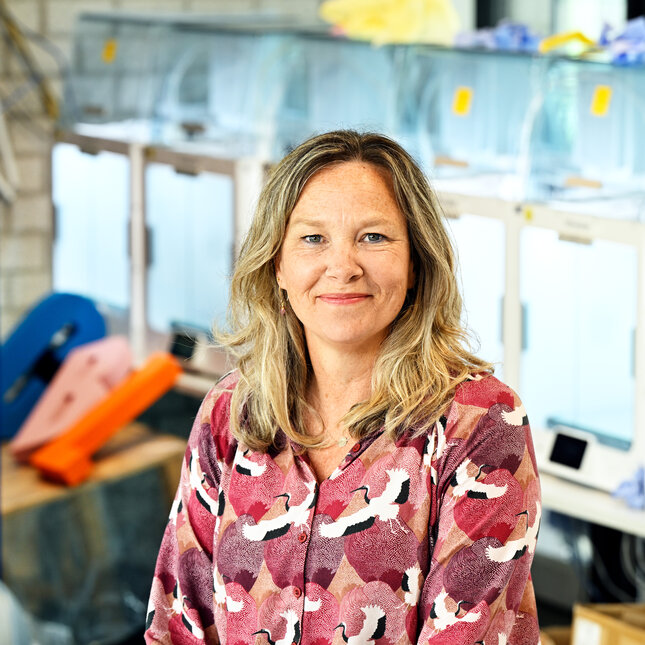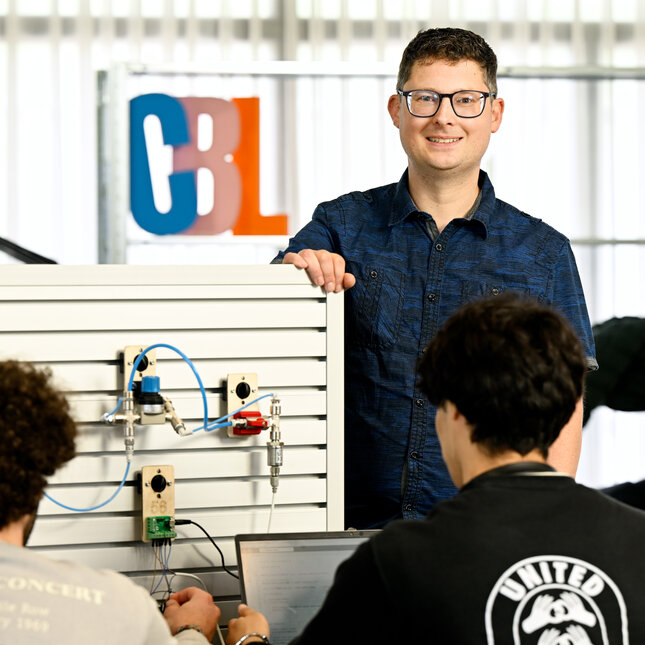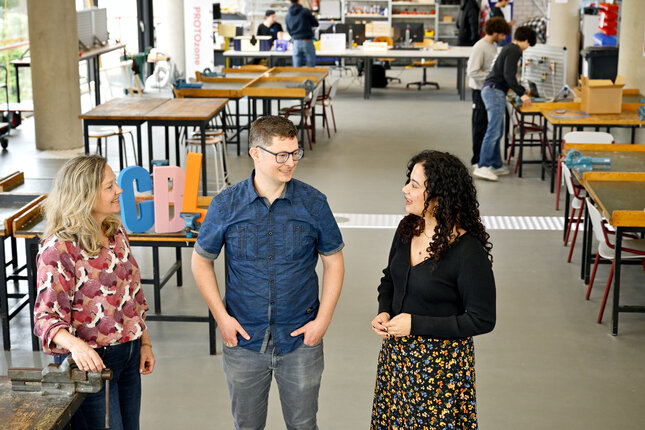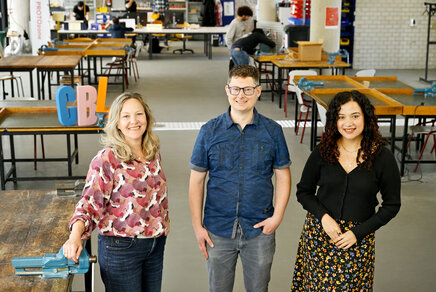'It takes a village to run a CBL course'
‘The Faces of Challenge-Based Learning’ series: associate professor Clemens Verhoosel works closely with coordinator Marieke Postema and educational advisor Apoorva Sonawane for his CBL course.

With the innovative educational concept of Challenge-Based Learning (CBL), we train the engineers of the future at TU/e. As of this academic year, CBL has a larger role in the curriculum of all our bachelor programs. This series of stories gives a face to the form of education that sometimes takes students - and teachers - out of their comfort zone, but above all prepares them for the challenges they will tackle as engineers. In this episode: at Mechanical Engineering, teachers, support staff, coordinators and tutors work intensively together on CBL education.
Running a CBL course is not something you can do alone. Hundreds of students working together in groups to solve an open challenge requires a lot of coordination, guidance, and coaching in addition to subject and didactic knowledge.
At the Department of Mechanical Engineering, nine major CBL courses are running in the bachelor's phase. One of these is Energy Storage and Transport by associate professor of Energy Technology Clemens Verhoosel, who has been teaching the course for several years and, since 2019, in CBL form.
Team effort
“Everyone has a role to play in CBL education,” Verhoosel knows from years of experience. "The teacher looks primarily at the subject knowledge he wants to impart and how best to do so didactically. I'm not the only teacher doing that, by the way. We have sixty groups of six students in the course, sixteen of which I supervise myself.”
“Our core team consists of five teachers, one CBL coordinator, thirty tutors, and six technical assistants. There are also people working on planning, administration, and scheduling,” Verhoosel sums up.
PROTO/zone
“Not to mention the PROTO/zone,” says CBL coordinator Marieke Postema. “That's where our students design, build, and test their ideas. There is a whole organization behind that as well, plus a coordinator. Indeed, it takes a whole village to run a CBL course,” she concludes.
What is Challenge-Based Learning?
In our innovative educational concept, students work together to experience how their discipline can contribute to the solving of challenges from the world around us. They learn which knowledge and expertise is needed to do so and can immediately apply and deepen the knowledge that they have acquired in practice by studying or doing research.
Together with students from other disciplines, as well as stakeholders from business, government or science, students learn to think at a system level. In the process, they also learn various other competencies, such as collaboration, communication, planning and organization.
Apoorva Sonawane is an educational advisor and education developer at Mechanical Engineering. “My job is to help design a course or convert a course to CBL. Clemens’ course had been running for a while when I started at TU/e. I help him with further developments.”
Review
Sonawane collaborates with teachers to determine how to grade students in CBL subjects. “Half of their grade is based on the team's project, and the other half is a personal assessment. This assessment focuses on the knowledge gained and the ability to work together. I guide teachers on which tools they can utilize for this purpose.”

Trio for CBL
Sonawane explains that within the department, they approach CBL education based on the principle of constructive alignment, which involves the trio of learning objectives, learning activities, and assessment.
“We intentionally bring together these three elements, with everyone fulfilling their respective roles and complementing each other. The teacher offers the subject knowledge and teaching methods. The CBL coordinator handles all aspects of course organization. And the teacher support staff assists with the (re)development of a course, for example.”
We all play our roles and complement each other.
Educational advisor Apoorva Sonawane
Verhoosel: “This model works for us. Not only does it ensure the quality of your course is up to standard, but it also clarifies responsibilities. Communication within our department is very efficient; if questions arise, we can quickly find each other.”
Short lines
Those short lines are essential because, over an eight-week period, 360 students take the Energy Storage and Transport course in 60 groups of six students. “That sometimes feels like a military operation because everything has to match up and fit together,” Verhoosel says.
With 360 students, this course sometimes feels like a military operation.
Associate professor Clemens Verhoosel
“Eight weeks is a short time, so everything must be planned in advance. Making interim adjustments is almost impossible,” Postema says. “Each time it’s a learning moment. Think about the emergence of artificial intelligence and new literature. We adjust the course after every round,” says Sonawane.
Organization of everything
Postema has been CBL coordinator at the Mechanical Engineering department since 2018. In this role, she is responsible for coordinating, planning, organizing, and facilitating all activities within the course. Additionally, she arranges training for professional skills such as collaboration, presentation, leadership, communication, and organization that students need to learn. Sonawane is responsible for developing these training programs.

Collaboration is crucial. We cannot do this without the help of tutors.
CBL coordinator Marieke Postema
Tutors
“An important part of my job is supervising the tutors who oversee sixty student groups,” Postema explains. “We have over two hundred tutors every year. These are master’s students who are required by their course to take on this responsibility. They are not always happy with their mandatory tutor role, but afterward, they all say it was a fantastic learning experience.”
“The knowledge they have acquired in this course can be applied to coaching undergraduate students; however, they all must undergo training and mentorship for this purpose.”
Training for tutors
Sonawane is currently working with an internal organization, CAPS, to develop a tutor training program. “We are focusing on the best ways to support and guide our tutors in their roles. We provide them with a thorough understanding of the course structure and its purpose, which helps to keep them motivated. During the training, we also communicate our expectations clearly to them.”
Teachers are responsible for content. Tutors for group dynamics and process.
Associate professor Clemens Verhoosel
“Tutors need to ensure that groups meet their deadlines and foster good group dynamics and cooperation. As for the content, that’s the responsibility of the teachers,” Verhoosel says.
Role of the teacher
In courses with a large number of students, teachers usually focus on coaching tutors and have minimal interaction with students. However, Verhoosel wanted to take a different approach. “I don't want to just deliver the course content and technical aspects. So, we decided that teachers would provide content coaching to student groups in weekly sessions. During these sessions, we will explore different problem-solving approaches with the groups and offer them tips for creating their models.”
Verhoosel does this with 16 groups of six students, while his four fellow teachers handle the remaining 44 groups. “Six students is a perfect group size. If the group is larger, members can duck out more easily and cut corners. And if I have to talk to nine students at once, it quickly feels like lecturing. With six students, it's easier to have a meaningful conversation.”

I get a lot of pleasure from coaching the groups myself.
Associate professor Clemens Verhoosel
He emphasizes that coaching the groups personally is not done in all CBL courses. “It’s my personal preference to do it that way and I get a lot of enjoyment out of it. I get a feel for what the groups are doing. I don’t get a stack of reports on my desk after eight weeks that I have to review when I have no idea what they have been working on or how the process went. I still have to review them now, but I know the groups thanks to those weekly coaching sessions. I see their enthusiasm growing and they surprise me more with creative solutions.”
Clemens-Based Learning
After the interview, we walk together to the PROTO/zone in Traverse, where Mechanical Engineering students turn their ideas into prototypes. This is where the CBL Energy Storage and Transport course comes to life, so to speak.
On the way, Sonawane jokes that the acronym CBL should actually be changed from Challenge-Based Learning to Clemens-Based Learning. “He was one of our first teachers to start working with CBL and is such a passionate believer.”
Verhoosel smiles affably and says, “I started converting my course to a CBL variant in 2019. Since then we’ve been running it, and we’re still fine-tuning. I am also involved in many other CBL projects and was on the sounding board group for the CBL toolkit.”
Sharing experiences
There is a lot of enthusiasm for CBL education at the Mechanical Engineering department, says Postema: “For further development, we have a CBL platform led by professor Rick de Lange. Within this platform, teachers, support staff and coordinators share their best practices with each other. That helps us become even better.”
Sparring with experienced teacher
Verhoosel emphasizes the importance of sharing experiences related to CBL. "Our department is expanding rapidly, both in terms of student enrollment and academic staff. The platform is beneficial for new teachers to get started."
“When I started CBL, Rick de Lange was my sounding board. It’s difficult for inexperienced teachers to judge how well their ideas work with students, so it’s nice to be able to discuss and get advice from someone with experience.”
Additional teachers
For the nine bachelor CBL courses, the department hired nine teachers. They are only involved in teaching but have technical backgrounds. “Teachers play different roles. We are no longer just content experts, but also coaches,” Verhoosel explains.
“I am ultimately responsible for the course and coach groups of students myself. In my course there are two additional teachers who have contact with the tutors, observe the social dynamics, and engage with the students. We work closely together and discuss how things are going.”

Tips for teachers
The three educators are eager to share their passion for CBL teaching with other teachers and offer some final tips. Above all, they emphasize the importance of cooperation and teamwork. Verhoosel suggests that teachers should not take on large courses alone and should instead make use of the support provided by their department.
Sonawane: “Maybe the way we approach CBL education comes across as a bit overwhelming, but it’s ultimately just a way of working together. There are many excellent examples to learn from and draw inspiration from other teachers. It doesn't have to be perfect immediately - give yourself and your course time and space to grow.”
You can’t anticipate everything in advance; it’s learning on the job.
Associate professor Clemens Verhoosel
“Start small and simple,” Postema says. “Accompany an experienced teacher. Learn their methods and determine what suits your course and department.”
“You can’t predict everything in advance; it’s learning on the job,” Verhoosel concludes. “Accept it when something doesn’t work and adjust. If you think you have a good idea:gto for it! Don’t be afraid to try something new.”
Written by
More Faces of Challenge-Based Learning
More on our strategy

![[Translate to English:]](https://assets.w3.tue.nl/w/fileadmin/_processed_/0/4/csm_OAY%202024%20Site%20Picture%201080x720%20px_e2e67b3e60.jpg)


